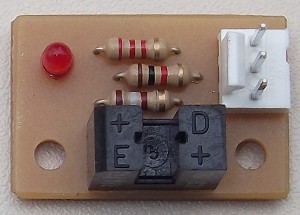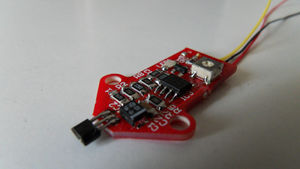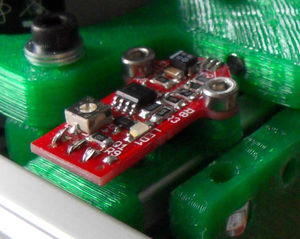Endstop
|
English • العربية • български • català • čeština • Deutsch • Ελληνικά • español • فارسی • français • hrvatski • magyar • italiano • română • 日本語 • 한국어 • lietuvių • Nederlands • norsk • polski • português • русский • Türkçe • українська • 中文(中国大陆) • 中文(台灣) • עברית • azərbaycanca • |
Toutes les imprimantes 3D RepRap à déplacement cartésien ont besoin d'avoir un point de départ (aussi appelé Home ou origine) servant de point de référence à tous leurs déplacements. Avant de commencer une impression, la tête doit revenir jusqu'au point de départ de chaque axe. Ces points de départ sont signalés par des interrupteurs (déclencheurs) que l'on appelle endstop ou limiteur de course ou encore fin de course. Ces limiteurs protègent aussi la machine en empêchant le chariot d'aller au-delà des limites d'impression, ce qui pourrait l'abîmer en butant sur le cadre.
Contents
Mécanique
, Les endstops mécaniques sont la forme la plus basique, constitués d'un interrupteur (switch) ordinaire à 2 fils. Le changement d'état de l'interrupteur envoie un signal à l'électronique.
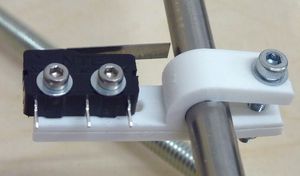
|
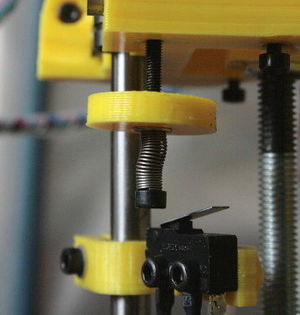
|
| Exemples de 2 limiteurs mécaniques : un tout simple et un autre ajustable sur l'axe Z. | |
Optique
These Optical Enstops observe the lightlevel and reacts to sudden changes.
E.g: Gen7 Endstop and Opto Endstop.
Magnétique
These endstops; Hall effect sensors is a transducer that varies its output voltage in response to a magnetic field. Hall effect sensors are used for proximity switching, positioning, speed detection, and current sensing applications.(--Wikipedia)
E. g: Hall-Θ.
Test
Le type de limiteur importe peu car il devrait être reconnus par votre électronique. Procédure à suivre :No matter which type of endstop you use, it should be recognized by your electronics. Test procedure:
- Allumer votre électronique et l'imprimante.
- Se connecter (via Pronterface/Printrun par exemple).
- Envoyer manuellement le code
M119. - Le firmware devrait renvoyer l'état "0" ou "open" (ouvert en français).
- Déclencher le limiteur en appuyant sur l'interrupteur, en insérant un bout de papier dans le détecteur optique, etc.
- Envoyer à nouveau le code
M119. - Le firmware devrait renvoyer l'état "1" ou "closed" (fermé en français).
Votre limiteur fonctionne si vous obtenez les deux retours comme prévu ci-dessus.
Problèmes
- Endstop shows no reaction at all.
- Measure the endstop signal on the cable connector plugged into your electronics or, even better, the CPU's signal pin. It should swap between < 1 V and > 2 V. If not, it's a wiring or electronics problem.
- Signal voltage changes, but M119 reports always the same.
- Then your firmware is misconfigured. Likely it reads the wrong CPU pin. Another possible cause is, you plugged your endstop into a different header.
- Endstop shows the opposite of the intended reaction.
- If your endstop reports "closed" while being untouched and "open" when engaged, the signal is interpreted the wrong way. On mechanical endstops you can change the wiring (see Mechanical Endstop). Common to all endstop types is, you can invert signal interpretation in your firmware (config.h, configuration.h, etc.).
- Endstops are generally unreliable.
- Especially when bundling endstop wiring with stepper motor wiring, there's quite a chance signals get induced "out of nowhere". Braiding or twisting these two or three wires helps enourmously (for reasons a bit too complex to explain here):
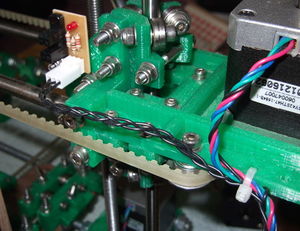
|
| Braided endstop wiring on a Sells Mendel. |
- Triggering one endstop changes report of two or three of them.
- First of all, while wiring up endstops it doesn't matter what unused ones report. The reason why unused ones change is, if their signal pin is totally disconnected, it picks up electromagnetic noise or whatever, making the signal pretty much random or even following another one.
- You should correct this before running the printer, though, e.g. by disabling unused endstops in your firmware. Most firmwares make assumptions depending on which endstops are enabled and which not. For example, firmwares do homing movements only for axes with endstops.
